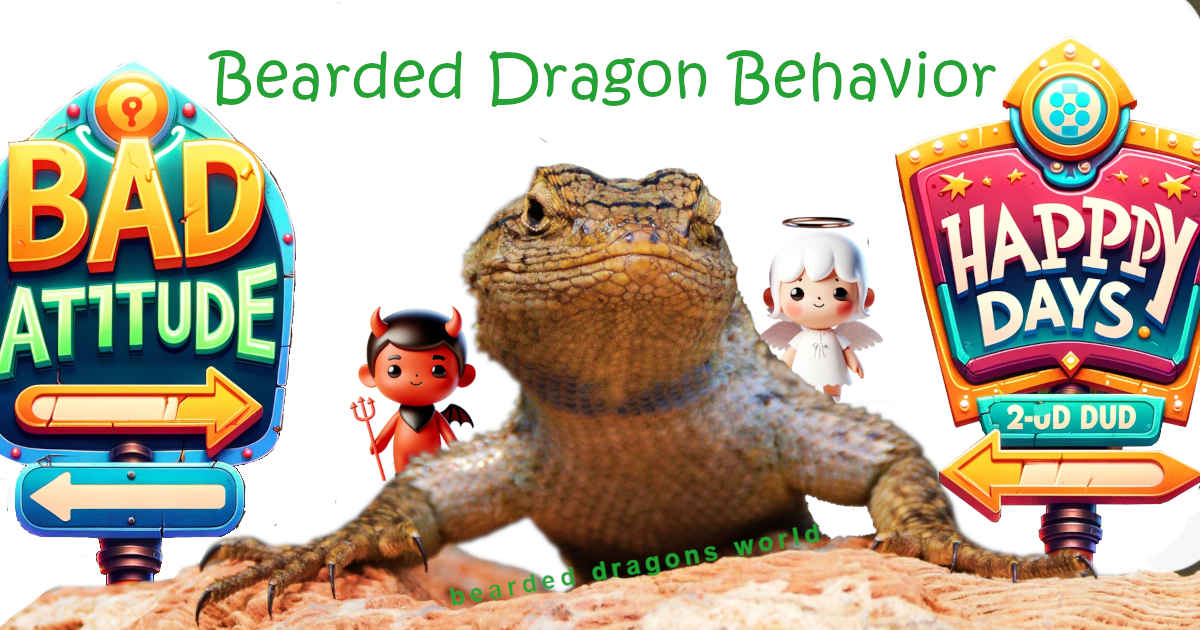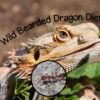Bearded dragon behavior is both fascinating and indicative of their well-being. From basking for thermoregulation to arm-waving as a form of social signaling, understanding the behaviors of a bearded dragon is essential for proper care.
Understanding bearded dragon behavior is key in assessing their health and environmental needs. Proper environmental management and enrichment are crucial in simulating their natural habitat, which in turn promotes typical bearded dragon behavior. Seasonal variations also play a role, with brumation common in colder months and heightened activity in warmer periods. Appropriate handling and interaction enhance their sociability and comfort, yet it’s vital to be attentive to any signs of stress or discomfort in their behavior.

Jump To:
- Understanding Bearded Dragon Behavior
- Environmental Management and Enrichment
- Seasonal Bearded Dragon Behavior
- Handling and Interaction
- Observing Abnormal Behaviors of a Bearded Dragon
Understanding Bearded Dragon Behavior
Bearded dragon behavior is a dynamic display of body language and gestures, communicating their emotional state and social interactions. From the darkening of their beard to signal stress to the distinctive arm waving as a form of greeting, these reptiles communicate in various fascinating ways.
Bearded dragons are increasingly recognized as sentient beings, capable of experiencing emotions such as pain, pleasure, and stress. This shift in understanding has significant legal implications. Countries like the UK, Australia, and others are amending animal welfare laws, ensuring that policies consider the emotional and cognitive complexities of reptiles. Such legislation emphasizes the need for humane treatment and welfare standards that go beyond basic physical health, acknowledging the mental and emotional well-being of bearded dragons and similar creatures, thereby transforming their care and protection in human society.
Emotional Intelligence
Bearded dragon behavior demonstrates a range of emotions. A black beard can indicate stress or aggression, whereas a relaxed posture with eyes partially closed might suggest contentment. They are responsive to their environment and can exhibit signs of recognition and adaptation to their caregivers’ patterns and behaviors.
Social Interactions and Communication
Social hierarchy plays a significant role in bearded dragon interactions. Dominant individuals may exhibit head bobbing as a sign of asserting control, while arm waving can be a gesture of submission. These behaviors help maintain the social order and reduce conflict within groups of bearded dragons.
Signs of Stress and Discomfort
When stressed or threatened, a bearded dragon may display a black beard, puff up its body, or glass surf—a term referring to the behavior when they repeatedly scratch at the glass walls of their enclosure. Hissing, biting, and keeping their mouth open are clear warnings that they feel uncomfortable or provoked.
Common Activities and Movements
Bearded dragons are known for basking under heat lamps, which is essential for thermoregulation. They also engage in digging, often to create a comfortable resting area or to regulate their body temperature. Head bobbing and twitching can be seen during social interactions and are normal part of their body language repertoire.
Territorial Behaviors with Humans and Other Bearded Dragons
Bearded dragons can exhibit territorial behaviors when interacting with humans or other dragons. Dominance is often displayed through head bobbing, where a dragon bobs its head rapidly to assert control, while submission can be seen when they perform slower arm waving gestures. Territorial disputes between dragons are common and can involve biting and chasing, particularly in the presence of potential mates.
Teodoro wants the ladies on bdw lol
Posted by Bearded Dragons World on Tuesday, May 13, 2014
Signs of Stress and Fear
Signs of stress include black beard, which indicates agitation, and glass surfing, where a dragon repeatedly scratches at the glass of their enclosure trying to escape. Stressful environments can also lead to hissing or keeping the mouth open, both of which serve as warnings to potential threats. A color change to darker hues and tail up posture may also signify distress or fear.
Common Activities and Movements
Normal bearded dragon behavior involves a variety of activities, ranging from basking for thermoregulation to digging as a natural instinct, possibly for making a nest or hiding. They might also exhibit head bobbing as a form of communication and arm waving as a non-threatening greeting or sign of recognition.
Reproductive Behaviors
During mating season, bearded dragon behavior changes. Males may become more territorial and perform a series of head bobs and arm waves to attract females or discourage rivals. Females could signal submission through arm waving and may exhibit digging behavior as they prepare for laying eggs. Both genders show a clear change in behavior indicating mating readiness, with males becoming more assertive and females appearing more receptive to the advances.
The mating process often begins with the male circling the female and may include gentle nipping and bobbing their heads. After mating, females may engage in digging behaviors as they prepare to lay eggs.
Bearded Dragon Sleep Behavior
Bearded dragons are diurnal, sleeping at night like humans. Understanding bearded dragon sleep patterns and behavior offers valuable insights into their well-being. They are diurnal creatures, mirroring human sleep habits, and require a dark, quiet environment at night. Observing their sleep behavior, including closed-eye resting and sensitivity to light, is important.
Creating an environment that mimics natural light cycles is essential. A consistent lighting cycle of light and dark, and a comfortable resting place are important for their health. Understanding their sleep behavior provides insights into their overall condition.
Environmental Management and Enrichment
Proper environmental management and enrichment are vital for the well-being of bearded dragons, addressing their territorial nature and preventing boredom through habitat simulation and response to stimuli.
Enclosure and Habitat
Bearded dragons require an enclosure that simulates their natural habitat to thrive. The setup to support bearded dragon thermoregulation is critical. The ideal enclosure should include an excellent temperature gradient for them to thermoregulate, as well as UVB lighting to assist in vitamin D3 synthesis.
Well set up environments reduce signs of stress, such as glass surfing, which can indicate the animal is trying to escape due to inadequate enclosure conditions.
Response to External Stimuli
Bearded dragon behavior is closely linked to their response to external stimuli, which can be indicative of their overall health and well-being. For instance, when feeling scared or threatened, a bearded dragon’s skin may darken – a behavior change that often serves as a warning sign of distress.
- Lighting: Proper cycles of light and darkness simulate natural conditions and support physiological rhythms.
- Predator Awareness: In the absence of real predators, it’s important to minimize stressors that might cause a bearded dragon to feel as if it’s in the presence of a predator. Reflections in the glass or movements outside their enclosure can often trigger a scared response.
Environmental Enrichment: Stimulating their environment with objects that promote exploratory behavior can improve their welfare. Research indicates that bearded dragons can benefit from physical and mental stimulation provided by environmental enrichment.
It’s imperative to regularly observe and interpret bearded dragon behaviors as they interact with their environment and enrichment tools. This will ensure that any negative issues such as territorial disputes or signs of stress are promptly addressed, contributing to a healthy life for these reptilian companions.
Seasonal Bearded Dragon Behavior
Bearded dragons exhibit distinct behaviors with the changing seasons, including variations in thermoregulation and social interactions, which are crucial for their survival and reproduction.
Brumation and Hibernation
A key aspect of bearded dragon behavior is their response to cooler temperatures, typically leading to brumation. This hibernation-like state is marked by lethargy and a notable decrease in activity as they conserve energy. During this period, owners may notice their bearded dragons basking less and exhibiting a reduced appetite. Brumation can extend for several weeks to months, significantly slowing the lizard’s metabolic rate.
Behavioral Changes in Captivity
Captivity can influence the seasonal behaviors of bearded dragons. For instance, handling during the cooler months should be minimized to respect their natural brumation cycle. Additionally, owners may note sudden changes in behavior, such as gaping, a sign of stress or thermoregulation. Providing a gradient of temperature in the enclosure, including both cooler and warm areas, is essential for the bearded dragon to exhibit normal seasonal behaviors, such as basking for heat and moving to a cooler zone to regulate their body temperature.
Adaptation to Climate Changes
Climate changes can prompt behavioral adaptations in bearded dragons. Seasonal shifts may cause variations in the display of dominant or submissive behavior as they react to environmental stressors. For example, they may become more lethargic during unusually extensive hot periods or exhibit increased activity during sudden warm spells in typically cool seasons. The ability to regulate body temperature through behaviors like changing color or seeking shade is pivotal for their adaptation to habitat fluctuations.
Handling and Interaction
Understanding the behaviors of a bearded dragon helps with interactions between pets and their owners. Interactions can range from mere observation to active handling and training, shaping both the pet’s behavior and their level of comfort. Proper technique and understanding of the bearded dragon’s body language are pivotal for a healthy relationship.
Taming Bearded Dragons
Taming a bearded dragon involves understanding their behavior, including their social hierarchy and territorial tendencies. Regular and gentle handling is key to this process. Through early and consistent interaction, bearded dragon behavior can evolve to include recognition of their owners and acceptance of handling, which helps in reducing aggression and fostering a more relaxed pet.
Approach and Touch
Understanding bearded dragon behavior is crucial when approaching them. Slow, cautious movements are essential to avoid eliciting a stress response. Sudden movements or approaching from above can trigger fear in these reptiles. To minimize defensive reactions like hissing or biting, it’s better to approach from the side and offer a flat hand for the dragon to step onto. This technique respects the natural behavior of bearded dragons and helps in building trust.
Bonding with the Owner
Bonding requires patience and routine. Bearded dragons may show head bobbing to assert dominance or wave in submission. Through repeated, positive interactions, these pets can develop a form of greeting and bonding with their owners. Understanding the behaviors of a bearded dragon can result in lowered stress and increased comfort with handling.
Recognizing Discomfort in Handling
Bearded dragon’s discomfort is an essential aspect of understanding bearded dragon behavior. Signs such as a black beard, open mouth, or hissing are clear indicators of stress or fear. In such instances, it’s crucial to gently return the dragon to its habitat and consider shorter, more gradual handling sessions in the future. Paying attention to these behaviors helps in preventing stress and potential aggression in bearded dragons.
Observing Abnormal Behaviors of a Bearded Dragon
When monitoring a bearded dragon, it is imperative to distinguish between normal and abnormal behaviors to ensure the reptile’s well-being. Abnormal behaviors can be indicative of stress, illness, or discomfort.
Twitching may signal neurological problems or could be a reaction to temperature fluctuations. If bearded dragons exhibit gaping without the presence of heat, it may be a sign of respiratory distress. They typically gape to regulate their body temperature, but it should not be confused with sustained mouth opening, which is concerning.
Changes in burrowing or hiding patterns mark another area of interest. While it is common for these reptiles to seek refuge, excessive hiding can denote illness or stress. Observing the use of Jacobson’s organ, which assists in scent detection, may help differentiate between exploratory behavior and signs of potential illness if paired with other abnormal behaviors.
Bearded dragons sometimes rub against objects, which is normal during shedding. However, continuous rubbing may suggest skin irritation or the presence of parasites. Overcrowding can lead to stacking, where one lizard lays atop another, which could stress subordinate individuals.
Be wary of sudden color changes. While bearded dragons can change color to communicate mood or for thermoregulation, a darkened color, especially in the beard, often indicates stress or aggression.
| Behavior | Potential Indication |
|---|---|
| Twitching | Neurological issues, Temperature sensitivity |
| Gaping (at rest) | Respiratory distress, Overheating |
| Excessive hiding | Illness, Stress |
| Continual rubbing | Skin irritation, Parasites |
| Stacking | Stress due to overcrowding |
| Darkened Color | Aggression, Stress |
Bearded dragon behavior outside the realm of normal activity warrants further investigation. Detailed information on differentiating between normal and abnormal behaviors can be found in resources like “Clinical Reptile Behavior”.
References
- Martínez Silvestre, A. (2014). How to Assess Stress in Reptiles. Journal of Exotic Pet Medicine, 23(3), 240–243.
- Arena, P. C., Bashaw, M. J., Grant, R., Howell, T., Martínez-Silvestre, A., & Warwick, C. (2023). Miscellaneous Factors. In Health and Welfare of Captive Reptiles (pp. 583-617). Cham: Springer International Publishing.
How can you tell if a bearded dragon is content?
A content bearded dragon often exhibits relaxed body language such as lying flat when basking, with a closed mouth and eyes that are not bulging. They may also show a willingness to be handled and an interest in their surroundings.
What is considered unusual or abnormal behaviors of a bearded dragon?
Unusual or abnormal behaviors of a bearded dragon can include frequent hiding, lack of appetite, or aggression. Such behaviors might indicate stress or illness, and you should consult a veterinarian if they persist.
How do bearded dragons communicate, and what behaviors indicate they are trying to send a message?
Bearded dragons communicate through body language, such as arm-waving to show submission or puffing their beard to appear more intimidating. Understanding these behaviors can help in interpreting their needs and moods
.





